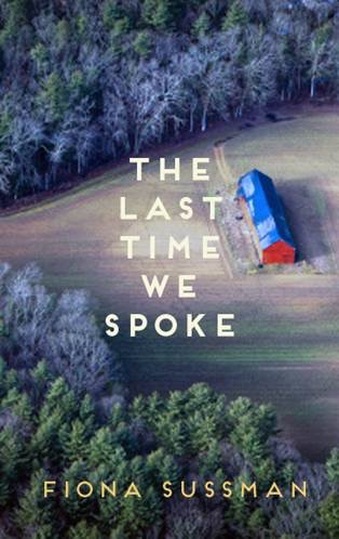
The Last Time We Spoke
by Fiona Sussman
Published by Allison & Busby in 2016, and containing 319 pages, this book came heralded as a winner of the Kobo/NZ Author Publishing Prize, and a shortlisted entrant for the NZ Heritage Book Awards. Could it really be that good? And if it is, what makes it so? And the answers are “Yes, it is” and “Everything”. But in expanding on those assertions I’m going to abandon the cool, academic detachment of the third person and give way to the viscera where the hugely-talented Sussman largely appealed to me and occasionally kicked me.
by Fiona Sussman
Published by Allison & Busby in 2016, and containing 319 pages, this book came heralded as a winner of the Kobo/NZ Author Publishing Prize, and a shortlisted entrant for the NZ Heritage Book Awards. Could it really be that good? And if it is, what makes it so? And the answers are “Yes, it is” and “Everything”. But in expanding on those assertions I’m going to abandon the cool, academic detachment of the third person and give way to the viscera where the hugely-talented Sussman largely appealed to me and occasionally kicked me.
First things first – The Last Time We Spoke is a redemption novel revolving around an unspeakable crime: a home invasion resulting in murder, maiming and rape. Carla has the misfortune to survive it where her husband and son do not and is condemned to live with her grief, her anger and her hate for the perpetrator, who gets fourteen years for his part in the crime. In addition to losing a family more precious even than most, her way of life and the certainties about it that most citizens take for granted and her hopes of any sort of future, Carla enters a downward spiral that skirts a predictable outcome which she survives by a thread.
That thread attains a tenuous strength through an epiphany that leads to her involvement with the perpetrator, Ben. Slowly, terribly slowly, and after the almost-inevitable false starts, she sets him, and herself, on the path to some sort of triumphant redemption. Teaching him to read is the least part of her effect upon him, for the beauty of her purpose tames the beast of his soul. Carla’s achievement is most touchingly encapsulated in the butterfly episode, but I resist the temptation to expand on that because it needs reading, re-reading and then reading some more.
So much for first things.
Second things: in looking at what makes this infinitely better than any other light-at-the-end-of-the-tunnel story, what was immediately apparent to me was the sheer power of the writing. The chief ingredient in this was the ring of authenticity present in the book from earliest times and throughout. Dialogue, attitude, behaviour and scene-setting all bespeak the investigation and research that went into painting colour, life and credibility into what might easily have been a down-and-dirty, monochromatic story of true bottom-feeders – or as Sussman has it, “the scum of the earth”.
Sussman has a truly enviable power to evoke, and I will forever covet some of her descriptive passages, viz. a girl with “eyes that were a catch-your-breath-blue”; a head-trauma patient with “his small face stuck on to his bandaged head”; the atmosphere inside a prison van which “was a foul brew of disinfectant, traffic fumes and old urine”, and the one that turned me inside out when she writes of Carla’s bereaved, devastated and desolate life “when every minute is empty and drags its feet toward nothingness”. I have never read a better description of the utter hopelessness of a life sentence that has nothing to do with prisons.
For me, much of the technical excellence of the book lies in Sussman’s clever juxtapositioning of characters and scenes. Two examples of many – we meet two women facing the watershed of pregnancy. Carla is inexpressibly overjoyed at a long-hoped-for miracle, while Miriama is resigned, apprehensive and despondent. Shortly after, we see the collision of two polarised worlds in the differing first-day-home experiences of Jack, whose entire life thereafter will be passed in the love and happiness of being wanted, and Ben, a mere by-blow who is lucky to survive his first night in the company of an abusive, selfish and violent father. ‘As the twig is bent...’
Chapters are linked by the presence of an Atua, an all-seeing eye who comments on the story as it develops and who can therefore offer the viewpoint of traditional Maoridom on events and characters. This is needed because, bereft of their tikanga, the Maori characters of the story cannot do so, and in my view it worked well although some of the proselytising grated; particularly the hoary old saw that the suppression of te reo was a Pakeha plot rather than an expression of Sir Apirana Ngata’s injunction of “E tipu e rea” to grasp “the tools of the Pakeha”.
The Last Time We Spoke is an absolute triumph. If you read only one book this Christmas, make it this one. If you read only one author, make it Fiona Sussman.
Flaxflower Review by M J Burr
Title: The Last Time We Spoke
Author: Fiona Sussman
Publisher: Allison&Busby (London)
Distributor NZ: Allen & Unwin (NZ)
RRP: $32.99
ISBN: 978-0-7490-2026-2
Formats: Print, Kindle, Kobo
Author: Fiona Sussman
Publisher: Allison&Busby (London)
Distributor NZ: Allen & Unwin (NZ)
RRP: $32.99
ISBN: 978-0-7490-2026-2
Formats: Print, Kindle, Kobo
No comments:
Post a Comment